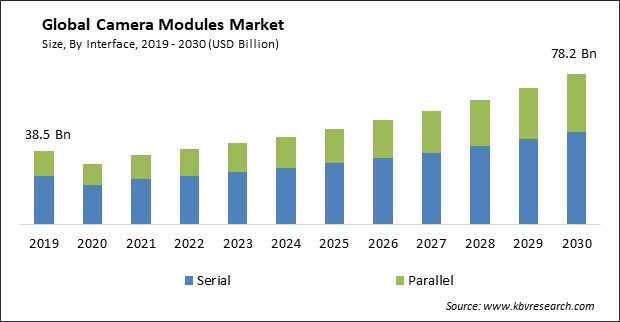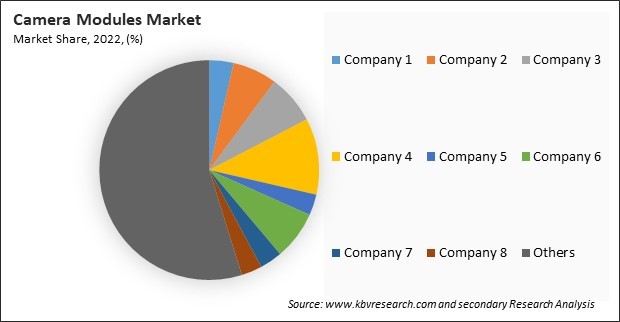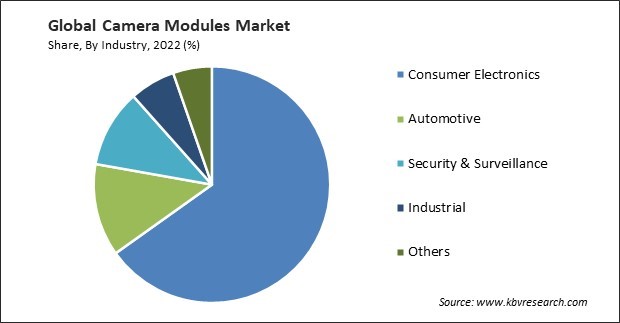
The Global Camera Modules Market size is expected to reach $78.2 billion by 2030, rising at a market growth of 9.2% CAGR during the forecast period. In the year 2022, the market attained a volume of 857.8 million units, experiencing a growth of 2.5% (2019-2022).
Complementary Metal-Oxide-Semiconductor (CMOS) image sensors have gained widespread popularity and become the dominant technology in various imaging applications, including digital cameras, smartphones, webcams, and more. Therefore, the CMOS Sensors would capture approximately half of the share of image sensors type market by 2030. CMOS sensors can achieve high readout speeds, allowing them to capture fast-moving subjects, record high-speed video, and support high-frame-rate imaging applications. This is particularly useful in sports photography, surveillance, and machine vision. Some of the factors impacting the market are widespread adoption of smartphones with integrated cameras, rising advancements in camera technology, and interoperability challenges and lack of workforce skills.

With the rise of social media platforms, there is a growing demand for visual content such as photos and videos. Consumers expect high-quality, feature-rich smartphone cameras to capture and share their experiences. Smartphones have become multifunctional devices, replacing many standalone gadgets like digital cameras. This consolidation has led to an increased focus on camera technology within the smartphone industry. Camera module manufacturers have innovated to create compact and slim camera modules that can fit into the slim profiles of modern smartphones, meeting consumers' design and aesthetic demands. Moreover, OIS technology reduces blurriness caused by shaky hands or movement while taking photos or recording videos. This feature is highly desirable for smartphone users, content creators, and photographers, driving demand for camera modules with OIS. Likewise, computational photography techniques, which involve software enhancements to optimize image quality, have become a key selling point for camera modules. Features like HDR (High Dynamic Range), night mode, and AI-based image processing rely on computational photography to deliver stunning results, boosting the appeal of camera modules. Therefore, these factors will boost the demand for camera modules in the upcoming years.
However, camera modules may not easily integrate with other components or systems in devices such as smartphones, drones, or IoT devices. This can hinder the adoption of camera modules in various applications. If different camera modules have proprietary interfaces or protocols, it can create a fragmented ecosystem where devices from different manufacturers are incompatible. This can confuse consumers and limit market growth. Also, the market requires a skilled workforce with optics, image processing, mechanical engineering, and semiconductor technology expertise. More skilled professionals are needed to ensure innovation and production capacity. Camera technologies are evolving rapidly, and keeping up with the latest advancements requires ongoing training and skill development.

The leading players in the market are competing with diverse innovative offerings to remain competitive in the market. The above illustration shows the percentage of revenue shared by some of the leading companies in the market. The leading players of the market are adopting various strategies in order to cater demand coming from the different industries. The key developmental strategies in the market are Acquisitions, and Partnerships & Collaborations.
Based on component, the market is divided into image sensors, lens modules, voice coil motor, and others. In 2022, the lens modules segment garnered a substantial revenue share in the market. Lens modules are a crucial component of smartphone camera modules. With the increasing demand for high-quality smartphone camera performance, there has been a consistent trend of improving camera technology. Smartphone manufacturers continue to invest in better lenses, image sensors, and optical image stabilization technologies. This trend is driven by consumer expectations for better photography and the rise of social media platforms where image quality matters. Therefore, the lens modules segment will expand more in the future.
By industry, the market is divided into consumer electronics, automotive, industrial, security & surveillance, and others. The consumer electronics segment attained the largest revenue share in the market in 2022. Consumer demand for better image and video quality has pushed camera module manufacturers to innovate. They have developed smaller, more capable camera modules with features like optical image stabilization (OIS), multiple lenses (e.g., wide-angle, telephoto), and advanced image processing algorithms. As a result, the demand in the segment is expected to rise in the future.

Based on pixel, the market is segmented into upto 7 MP, 8-13 MP, and above 13 MP. The upto 7 MP segment attained the largest revenue share in the market in 2022. Camera modules with resolutions of up to 7 MP are suitable for document scanning and OCR (optical character recognition). This makes them valuable for business applications and scanning receipts, contracts, or documents on mobile devices. Investing in camera modules with resolutions up to 7 MP ensures that devices remain competitive and relevant as higher-resolution displays become more common. This trend has contributed to the growth of the segment.
By focus type, the market is bifurcated into auto focus and fixed focus. The auto focus segment attained a significant revenue share in the market in 2022. Camera module manufacturers have been developing more advanced autofocus technologies. This includes phase detection autofocus (PDAF), laser autofocus, dual-pixel autofocus, and more. These technologies improve the speed and accuracy of autofocus, enhancing the overall camera performance. Artificial intelligence (AI) and machine learning algorithms have been increasingly used in camera modules to enhance autofocus capabilities. AI can predict and track subjects, leading to faster and more precise autofocus in various shooting conditions. These factors will boost the demand in the autofocus segment.
On the basis of interface, the market is partitioned into serial and parallel. The serial segment acquired the highest revenue share in the market in 2022. One of the significant drivers for the serial segment in the market is the increasing trend of incorporating multiple cameras in smartphones. Manufacturers are designing smartphones with dual, triple, or even quad-camera setups to enhance photography capabilities. This trend creates a demand for camera module serial connections within the devices. Therefore, there will be an increase in demand in the serial segment.
| Report Attribute | Details |
|---|---|
| Market size value in 2022 | USD 39.2 Billion |
| Market size forecast in 2030 | USD 78.2 Billion |
| Base Year | 2022 |
| Historical Period | 2019 to 2021 |
| Forecast Period | 2023 to 2030 |
| Revenue Growth Rate | CAGR of 9.2% from 2023 to 2030 |
| Number of Pages | 596 |
| Number of Table | 1280 |
| Quantitative Data | Volume in Million Units, Revenue in USD Million, and CAGR from 2019 to 2030 |
| Report coverage | Market Trends, Revenue Estimation and Forecast, Segmentation Analysis, Regional and Country Breakdown, Market Share Analysis, Companies Strategic Developments, Company Profiling |
| Segments covered | Component, Interface, Focus Type, Pixel, Industry, Region |
| Country scope | US, Canada, Mexico, Germany, UK, France, Russia, Spain, Italy, China, Japan, India, South Korea, Singapore, Malaysia, Brazil, Argentina, UAE, Saudi Arabia, South Africa, Nigeria |
| Growth Drivers |
|
| Restraints |
|
On the basis of region, the market is segmented into North America, Europe, Asia Pacific, and LAMEA. The Asia Pacific segment acquired the largest revenue share in the market in 2022. APAC includes a diverse set of countries, some considered emerging sectors. These sectors have witnessed a growing middle class with increasing disposable income, driving demand for consumer electronics, including smartphones and digital cameras. This has contributed to the growth of camera module sales in the region.
Free Valuable Insights: Global Camera Modules Market size to reach USD 78.2 Billion by 2030
The market research report covers the analysis of key stake holders of the market. Key companies profiled in the report include Hon Hai Precision Industry Co., Ltd., Sony Corporation, Intel Corporation, Samsung Electro-Mechanics Co., Ltd. (Samsung Electronics Co., Ltd.), Fujifilm Holdings Corporation, OmniVision Technologies, Inc. (OmniVision Group-Shanghai Weir Semiconductor Co., Ltd.), ams-OSRAM AG, STMicroelectronics N.V., Sharp Corporation, and ON Semiconductor Corporation.
By Interface (Volume, Million Units, USD Million, 2019-2030)
By Focus Type (Volume, Million Units, USD Million, 2019-2030)
By Pixel (Volume, Million Units, USD Million, 2019-2030)
By Component
By Industry (Volume, Million Units, USD Million, 2019-2030)
By Geography (Volume, Million Units, USD Million, 2019-2030)
The Market size is projected to reach USD 78.2 billion by 2030.
Widespread adoption of smartphones with integrated cameras are driving the Market in coming years, Interoperability challenges and lack of workforce skills restraints the growth of the Market.
Hon Hai Precision Industry Co., Ltd., Sony Corporation, Intel Corporation, Samsung Electro-Mechanics Co., Ltd. (Samsung Electronics Co., Ltd.), Fujifilm Holdings Corporation, OmniVision Technologies, Inc. (OmniVision Group-Shanghai Weir Semiconductor Co., Ltd.), ams-OSRAM AG, STMicroelectronics N.V., Sharp Corporation, and ON Semiconductor Corporation.
In the year 2022, the market attained a volume of 857.8 million units, experiencing a growth of 2.5% (2019-2022).
The Fixed Focus segment is leading the Market by Focus Type in 2022 thereby, achieving a market value of $44.2 billion by 2030.
The Asia Pacific region dominated the Market by Region in 2022, and would continue to be a dominant market till 2030; thereby, achieving a market value of $33.6 billion by 2030.
Our team of dedicated experts can provide you with attractive expansion opportunities for your business.
